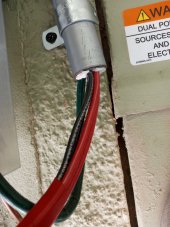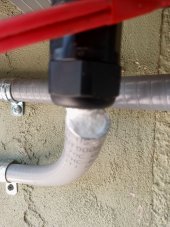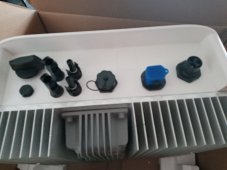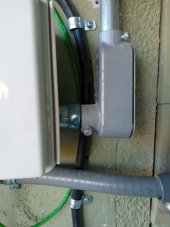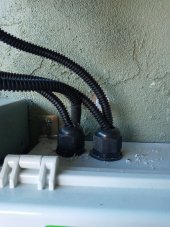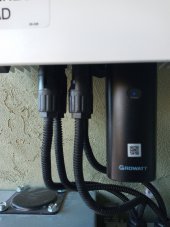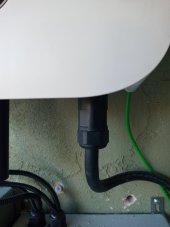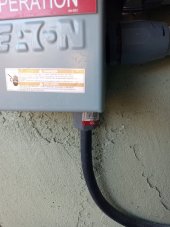George_Moore
New Member
- Joined
- May 3, 2022
- Messages
- 24
I am doing a DIY grid tie in Southern California.
I am using 16 panels in 2 strings to a string inverter going into an AC disconnect box before connection to the grid.
I am using a Growatt MIN-6000-TL-X inverter.
The issue is this: This model inverter has simplified installation using external plugs. I cannot terminate conduit to their box, as the box is never opened. All connections are external.
Most instructions I see for other systems show conduit going into the box for DC and conduit coming out of the box for AC. I can't do that.
The inverter DC input is through 4 MC4 plugs, 2 for each string.
The output from the box is through a large AC plug. I have attached a photo of the bottom of the box.
So, I have conduit coming off the roof, and at the end of the conduit my 4 wires come out, which I have attached MC4 connectors to, and they attach to the inverter.
1.) The end of the conduit just sits there with the wires coming out. What is the right thing to do here for compliance?
The AC has a plug but I THINK I am not allowed to use SOOW for running the two feet to the AC Disconnect. So, I have 3 wires coming out of the plug on the inverter and they go into liquidtight flexible conduit than then goes to the AC Disconnect. I sealed them with silicon to comply with being watertight, but ...
2. Wires from a plug going into conduit can't be the right thing to do. Is SOOW ok for this, or is there a proper way to make a connection between the plug and the conduit? That is, can I run SOOW from the inverter to the AC Disconnect box?
I have attached some photos. What is the right way to handle the two transitions?
I am using 16 panels in 2 strings to a string inverter going into an AC disconnect box before connection to the grid.
I am using a Growatt MIN-6000-TL-X inverter.
The issue is this: This model inverter has simplified installation using external plugs. I cannot terminate conduit to their box, as the box is never opened. All connections are external.
Most instructions I see for other systems show conduit going into the box for DC and conduit coming out of the box for AC. I can't do that.
The inverter DC input is through 4 MC4 plugs, 2 for each string.
The output from the box is through a large AC plug. I have attached a photo of the bottom of the box.
So, I have conduit coming off the roof, and at the end of the conduit my 4 wires come out, which I have attached MC4 connectors to, and they attach to the inverter.
1.) The end of the conduit just sits there with the wires coming out. What is the right thing to do here for compliance?
The AC has a plug but I THINK I am not allowed to use SOOW for running the two feet to the AC Disconnect. So, I have 3 wires coming out of the plug on the inverter and they go into liquidtight flexible conduit than then goes to the AC Disconnect. I sealed them with silicon to comply with being watertight, but ...
2. Wires from a plug going into conduit can't be the right thing to do. Is SOOW ok for this, or is there a proper way to make a connection between the plug and the conduit? That is, can I run SOOW from the inverter to the AC Disconnect box?
I have attached some photos. What is the right way to handle the two transitions?
Attachments
Last edited:



